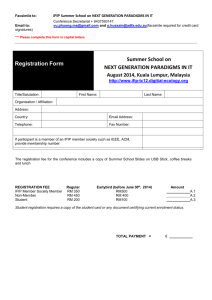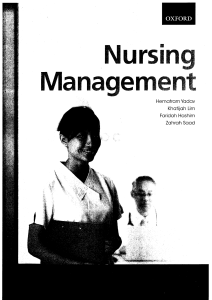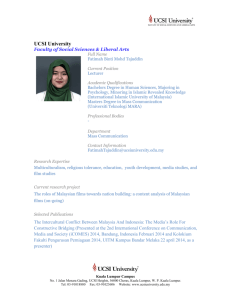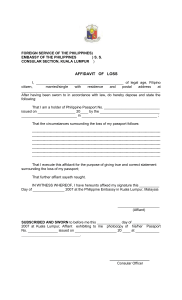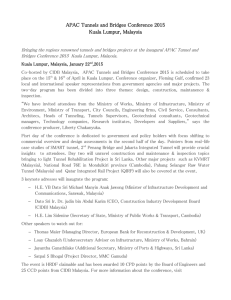Powerpoint
advertisement
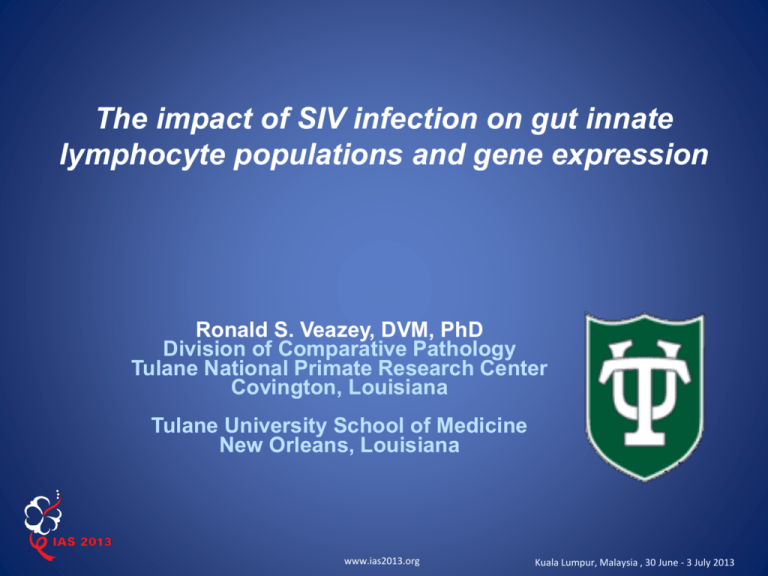
The impact of SIV infection on gut innate lymphocyte populations and gene expression Ronald S. Veazey, DVM, PhD Division of Comparative Pathology Tulane National Primate Research Center Covington, Louisiana Tulane University School of Medicine New Orleans, Louisiana www.ias2013.org Kuala Lumpur, Malaysia , 30 June - 3 July 2013 Differences between innate and adaptive immunity? • Adaptive immunity previously defined as having ”immunologic memory” but lines are increasingly blurred – innate lymphoid cells (ILC) do not have antigen specific receptors (CD3) • Emerging evidence shows innate lymphoid cells develop independently in GALT, and develop immunologic memory • Murine studies indicate GALT develops through immune responses to bacteria mediated through specialized ”Lymphoid tissue inducer” (Lti), possible stem cells, and other innate lymphoid cell (ILC) subsets www.ias2013.org Kuala Lumpur, Malaysia , 30 June - 3 July 2013 Innate lymphoid cells Newly proposed nomenclature: Spits, H., D. Artis, et al. (2013). "Innate lymphoid cells--a proposal for uniform nomenclature." Nat Rev Immunol 13(2): 145-149. “ILCs should be categorized into three groups based on the cytokines that they can produce and the transcription factors that regulate their development and function” • Group 1: ILC1: ILCs that produce IFNγ. Prototypical member is the NK cell. NK cells display both cytotoxic activity, and produce IFNγ following activation. • Group 2: ILC2: ILCs that produce type 2 cytokines (including IL-5 and IL-13) and are dependent on GATA-binding protein 3 (GATA3) and retinoic acid receptor- related orphan receptor-α (RORα) for development and function. • Group 3: ILC3: ILCs that produce IL-17 and/or IL-22 and depend on the transcription factor RORγt for development and function. Lymphoid tissue inducer cells (LTi) are prototype. www.ias2013.org Kuala Lumpur, Malaysia , 30 June - 3 July 2013 Innate lymphoid cells • Proinflammatory retinoic-acid-receptor-related orphan receptorgammat-positive (RORgammat+) innate lymphoid cells (ILCs) differentiate from distinct fetal liver RORgammat(+) precursors and are crucial for immune homeostasis (ILC17, 22, etc.). Sawa, Eberl et al., 2010. Lineage relationship analysis of RORgammat+ innate lymphoid cells. Science 330:665-669. • Mucosal (RORgammat(+)innate lymphoid cells (ILCs) are an important innate lymphocyte population required for immunity to intestinal infections Klose, Diefenbach, et al., 2013. A T-bet gradient controls the fate and function of CCR6-RORgammat+ innate lymphoid cells. Nature 494:261-265. • ILC regulate CD4+ T-cell responses to intestinal bacteria. Hepworth, Sonnenberg et al, 2013. Innate lymphoid cells regulate CD4+ T-cell responses to intestinal commensal bacteria. Nature 498:113-117. www.ias2013.org Kuala Lumpur, Malaysia , 30 June - 3 July 2013 Recent studies of NK / ILC in SIV-infected macaques Blood. 2010 Jun 3;115(22):4439-46. Epub 2010 Mar 25. CD16- natural killer cells: enrichment in mucosal and secondary lymphoid tissues and altered function during chronic SIV infection. Reeves RK,……Johnson RP. Blood. 2011 Sep 22;118(12):3321-30. Epub 2011 Jul 26. Gut inflammation and indoleamine deoxygenase inhibit IL-17 production and promote cytotoxic potential in NKp44+ mucosal NK cells during SIV infection. Reeves RK, …Johnson RP. PLoS Pathog. 2012 September; 8(9) Loss of Effector and Anti-Inflammatory Natural Killer T Lymphocyte Function in Pathogenic Simian Immunodeficiency Virus Infection. Namita Rout,…Amitinder Kaur PLoS Pathog. 2012;8(8) ADCC develops over time during persistent infection with live-attenuated SIV and is associated with complete protection against SIV(mac)251 challenge. Alpert MD, ….Evans DT. www.ias2013.org Kuala Lumpur, Malaysia , 30 June - 3 July 2013 Phenotyping innate lymphoid cells (ILC) in normal macaque blood (Xu, Veazey et al, Mucosal Immunol 2012) Gating strategy: Lineage negative, CD3negCD8++ C3negCD8a HIGH (ILC’s) C3negCD8a neg (DC, B cells, etc.) www.ias2013.org Kuala Lumpur, Malaysia , 30 June - 3 July 2013 CD16 detection is artificially masked by some anti-SIV immune complexes Comparison of anti-human CD16 mAb clones on SIVinfected macaque cells before and after “washing” SIV/IgG immune complexes in SIV-infected macaques block detection of CD16 but not cytolytic activity of natural killer cells. Wei and Fultz, et al, Clin and Vacc Immunol 2006 CD16 clone DJ130 (Dako) best results www.ias2013.org Kuala Lumpur, Malaysia , 30 June - 3 July 2013 ILC that secrete IL-17 are restricted to mucosal tissues in macaques Lymphocytes IL-17+ 9.35 26.1 IL-17 PBMC CD3+CD4+ (Th17) CD3+CD8+ (Tc17) CD3-CD8high (ILC) Jej LPL 1.72 19.2 0.289 29.3 0.0385 25.7 73.5 CD3 Colon LPL 3.51 3.67 11.1 Spleen 0.36 Tonsil 0.468 Duodenum 1.78 0.502 0.284 2.96 0.181 2.74 13.9 IL-17 www.ias2013.org Kuala Lumpur, Malaysia , 30 June - 3 July 2013 IL-17 secreting cells in jejunum of normal rhesus macaques * Blood. 2008 Oct 1;112(7):2826-35. Differential Th17 CD4 T-cell depletion in pathogenic and nonpathogenic lentiviral infections. Brenchley…Douek, et al. www.ias2013.org Kuala Lumpur, Malaysia , 30 June - 3 July 2013 Intestinal ILC17 cells are depleted in SIV infection www.ias2013.org Kuala Lumpur, Malaysia , 30 June - 3 July 2013 Summary: Some ILC17 (ILC3) cells secrete IL-22, TNF-a, but not IFN-g nor granzyme B (not cytolytic) SIV infection results in significant loss of ILC17 cells, especially in the jejunum, which persists throughout SIV infection. Loss of ILC17 cells (and IL-17 in general) may contribute to loss of intestinal mucosal integrity and disease progression in human immunodeficiency virus (HIV)/SIV infection. www.ias2013.org Kuala Lumpur, Malaysia , 30 June - 3 July 2013 Changes in intestinal gene expression in SIV: Experimental Design N=5 SIV infection pre infection (6 weeks) Resection biopsy 6-8 cm 90d post infection Resection biopsy 6-8 cm 21 d post infection Resection biopsy 6-8 cm Approach to reduce tissue complexity Separation by Percoll gradients: Small Intestine (Jejunum) Intraepithelial Lymphocytes Epithelial cells (Enterocytes) Lamina propria Cells (LPC’s) www.ias2013.org Fibrovascular stroma Kuala Lumpur, Malaysia , 30 June - 3 July 2013 Genome wide changes in the jejunum lamina propria in SIV infection (measured by Affymetrix rhesus arrays - 54,675 capture probes) 1) Intestinal lamina propria www.ias2013.org Kuala Lumpur, Malaysia , 30 June - 3 July 2013 www.ias2013.org Kuala Lumpur, Malaysia , 30 June - 3 July 2013 www.ias2013.org Kuala Lumpur, Malaysia , 30 June - 3 July 2013 Upregulation of multiple genes associated with immune activation www.ias2013.org Kuala Lumpur, Malaysia , 30 June - 3 July 2013 Downregulated genes associated with oxidative phosphorylation, IFNg, IL-17, B cell “help” www.ias2013.org Kuala Lumpur, Malaysia , 30 June - 3 July 2013 Gene changes in lamina propria in chronic (90 days) SIV infection www.ias2013.org Kuala Lumpur, Malaysia , 30 June - 3 July 2013 Important Up-regulated genes at 90 d PI LBP (lipopolysaccharide binding protein) Expressed by macrophages and Paneth cells in response to LPS LBP-LPS complex together with CD14 activates TLR4 pathway CD70 Cytokine that belongs to the TNF family of ligands Expressed only on activated T cells (CD4 & CD8) and binds to CD27 (receptor) Induces proliferation of co-stimulated T cells May bind CD27 on memory B cells and induce plasma cell differentiation (hypergammaglobulinemia) CD38 Ectoenzyme and an activation marker for CD4, CD8 and B cells JNK3 (Jun-N-terminal kinase 3) Activated by LPS and proinflammatory cytokines www.ias2013.org Kuala Lumpur, Malaysia , 30 June - 3 July 2013 Important Down-regulated genes at 90 d PI CXCL18 Chemotactic for naïve T cells and non activated lymphocytes May be a protective response (moderation of inflammation) TLR8 Binds ssRNA (HIV/SIV) Signaling induces IFNa production leading to immune activation Downregulation may be a protective response or cellular dysfunction (DC, mac) IL-8 Produced mainly by macrophages, dendritic cells Can Inhibit HIV replication in PBMCs and ectocervical tissue explants AICD Required for somatic hypermutation and class switch recombination www.ias2013.org Kuala Lumpur, Malaysia , 30 June - 3 July 2013 Intestinal Epithelium PLoS One. 2013; Intestinal Epithelium Reveals Transcriptional Signatures Consistent with Disturbances in Enterocyte Maturation and Differentiation during the Course of SIV Infection. Mohan, Veazey, Lackner et al. www.ias2013.org Kuala Lumpur, Malaysia , 30 June - 3 July 2013 Gene changes in intestinal epithelium in acute (21 days) SIV infection www.ias2013.org Kuala Lumpur, Malaysia , 30 June - 3 July 2013 www.ias2013.org Kuala Lumpur, Malaysia , 30 June - 3 July 2013 www.ias2013.org Kuala Lumpur, Malaysia , 30 June - 3 July 2013 Transcription factors and signaling pathways known to regulate intestinal epithelial gene expression 1. Wnt-TCF7L2 /TCF4 signaling: Crypt cell proliferation Paneth cell differentiation Directs epithelial cell migration along the Villi 2. NOTCH signaling: Crypt cell proliferation and cell fate decisions 3. Sonic and Indian Hedgehog signaling: Crypt formation, spacing and villus development 4. EPH/Ephrins: Regulated by Wnt signaling: Progenitor cell migration up the crypt 5. PTEN/PI3K: Crypt stem cell renewal 6. BMP signaling: Crypt stem cell proliferation independent of Wnt signaling 7. LKB1 signaling: Regulates epithelial cell polarity www.ias2013.org Kuala Lumpur, Malaysia , 30 June - 3 July 2013 Wnt-catenin-TCF7L2 signaling pathway WNT LRP Dkk CK1 Axin Frizzled Dsh/ Dvl Downregulated d21: GSK3 Wnt 10A Frizzled TCF7/TCF4 Dsh/ Dvl -catenin CK1 GBP P GSK3 Axin -catenin APC Ub CK1 -TrCP Groucho Pygo BCL9 CBP -catenin TCF4/LEF Target Genes Myc, Cyclin D1 TCF1, PPAR- MMP-7, Axin-2 CD44 www.ias2013.org Kuala Lumpur, Malaysia , 30 June - 3 July 2013 Gene changes in intestinal epithelium in chronic (90 days) SIV infection www.ias2013.org Kuala Lumpur, Malaysia , 30 June - 3 July 2013 Upregulated genes in the intestinal epithelium at 90 d PI (most involved with epithelial cell proliferation) NOTCH and NOTCH target genes (HES4, HES7) and EZH2 (histone methyltransferase) ETS homologous factor: Regulate epithelial cell proliferation and differentiation FGF4 and 12: Fibroblast growth factor 4 and 12 Stimulates intestinal epithelial cell proliferation Kruppel like factor 12: Induces cell proliferation (up in invasive gastric cancers) PI3K regulatory subunit 2 (beta), Inositol polyphosphate-4-phosphatase, type 1 Increases cell survival, growth and proliferation (altered in 40% of colorectal cancers) Defensin Beta 119 Antimicrobial peptide Mucin 5B, BMPR1A Upregulated in H. pylori induced gastric disease (anti-microbial ?) Lubricates intestinal contents www.ias2013.org Kuala Lumpur, Malaysia , 30 June - 3 July 2013 Downregulated genes in the intestinal epithelium at 90 d PI (most involved in epithelial differentiation and defense) Paraxonase: Epithelial Defense response to pathogens PDX1: Pancreatic and duodenal homeobox 1 Regulates gene expression in Enteroendocrine cells Focal Adhesion Kinase: Important for epithelial cell motility, survival and healing Kruppel like factor 6 and 10 A ubiquitous transcription factor that induces cell differentiation FOXP2 and P4: Epithelial cell specification and differentiation TGF 3: Induces cell differentiation and possess anti-inflammatory properties Mucin 13: Cell signaling in epithelial cells Solute carrier family 5 and 15: Uptake and digestion of tripeptides and monocarboxylates www.ias2013.org Kuala Lumpur, Malaysia , 30 June - 3 July 2013 Cell adhesion Molecules downregulated 90 d PI: Tight Junctions Claudin 22 Angiomotin like-1 Adherens Junctions Cadherin 5, 11, 23 Catenin (Cadherin associated protein) alpha 1 (Anchor protein links Cadherins to actin filament) Desmosomes Desmoglein 2: Component of Desomosomes Desmocollin: Component of Desomosomes Junctional Plakoglobin: Component of Desomosomes Hemidesmosomes Laminin beta 3, 4, gamma 1, gamma 2 Required for hemidesmosome assembly Binding, attaching and migration of cells (epithelial healing) Integrin alpha 1, 3 and 6 Receptor for laminins Plays a critical structural role in hemidesmosomes www.ias2013.org Kuala Lumpur, Malaysia , 30 June - 3 July 2013 Summary: Early SIV infection results in upregulation of genes associated with intestinal epithelial apoptosis, proliferation, and repair Upregulation of numerous genes associated with lymphocyte activation, LPS pathways Downregulation of most epithelial adhesion / tight junction molecules indicating early barrier dysfunction Downregulation of anti-microbial genes www.ias2013.org Kuala Lumpur, Malaysia , 30 June - 3 July 2013 Acknowledgements Tulane National Primate Research Center Huanbin Xu Mahesh Mohan Terri Rasmussen Andrew Lackner Case Western Reserve University Michael Lederman Eric Arts Cornell University John Moore Pj Klasse Northwestern University, Chicago Tom Hope St George’s Hospital, London Robin Shattock Queens University Belfast Karl Malcolm NCI-Frederick Jeff Lifson Mike Piatak Washington University, MO Herbert “Skip” Virgin Scott Handley NIH / NIAID Nancy Miller Susan Plaeger Opendra Sharma Jim Turpin www.ias2013.org Kuala Lumpur, Malaysia , 30 June - 3 July 2013
